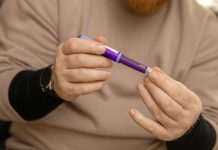
Diabetes is a major health issue that affects millions of people worldwide.
It’s a condition that makes your blood sugar levels go too high, and it’s one of the top ten causes of death globally.
A common and serious complication of diabetes is diabetic foot ulcer (DFU). About 25% of people with diabetes will get a DFU.
Often, by the time these foot ulcers are noticed, over half are already infected, leading to over 70% of cases resulting in the removal of the lower limb.
Treating DFUs is not easy. It requires multiple approaches and is both expensive and time-consuming. Unfortunately, many treatments fail, leading to amputations.
A New Approach to Treatment
Researchers at Queen’s University Belfast have now created a new way to treat DFUs.
They’ve made a kind of bandage, called a scaffold, using 3D bioprinting. This scaffold releases antibiotics over a four-week period to help heal the wound.
Recent studies have been looking at using these kinds of drug-loaded scaffolds to treat DFUs. These scaffolds work like carriers, delivering cells and drugs to the wound to help it heal.
How the New Bandages Work
These special bandages are like windows that let doctors keep an eye on how the wound is healing. This means they don’t need to be removed often, which can risk infection and slow down the healing process.
The scaffold is made of two parts – a “frame” and “glass.” The frame contains an antibiotic that helps kill off any bacteria in the wound.
The glass, made of collagen/sodium alginate, contains a growth factor that encourages new cell growth. These two parts both play a key role in healing the wound.
The Future of DFU Treatment
This new research, which will be presented by Professor Dimitrios Lamprou at an upcoming workshop, could have a big impact on treating DFUs.
Not only could it improve the quality of life for patients, but it could also reduce the cost and time it takes to treat these wounds.
According to Ms. Katie Glover, the lead author of the study, this new scaffold could revolutionize DFU treatment.
She says, “Using bioprinting technology, we have developed a scaffold with suitable mechanical properties to treat the wound, which can be easily modified to the size of the wound.
This provides a low-cost alternative to current DFU treatments. It could significantly improve patient outcomes while reducing the economic burden caused by the increasing demand for treatment as the number of people with diabetes continues to rise each year.”
If you care about diabetes, please read studies that pomace olive oil could help lower blood cholesterol, and honey could help control blood sugar.
For more information about diabetes, please see recent studies about Vitamin D that may reduce dangerous complications in diabetes and results showing plant-based protein foods may help reverse type 2 diabetes.
The study was published in Drug Delivery and Translational Research.
Follow us on Twitter for more articles about this topic.
Copyright © 2023 Knowridge Science Report. All rights reserved.



